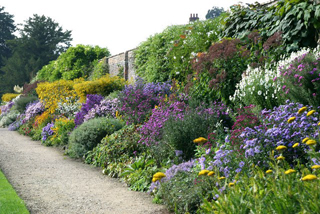 There is so much to this month, it’s difficult to know where to start!
There is so much to this month, it’s difficult to know where to start!
So April has arrived and hopefully with it, some warmth. Whilst writing this, it’s quite chilly at night so plant out anything small with due care, as there is still the chance of a crispy white morning and anything tender really won’t like it.
If the weather is reasonable, the ground should be warming up nicely so now is a great time to get herbaceous perennials in the ground. These are plants which come back year after year; well, most do if they haven’t had to swim all winter, but they don’t go woody like a tree or shrub.
 These are great plants for adding colour to a garden; they come in all shapes and sizes and there is something for every garden position. If you have an area in your garden which is, perhaps, all spring-flowering, consider using perennials to give you later colour – for example, phlox for scent and summer colour, Japanese anemones for late summer colour, Michaelmas daisies for the autumn.
These are great plants for adding colour to a garden; they come in all shapes and sizes and there is something for every garden position. If you have an area in your garden which is, perhaps, all spring-flowering, consider using perennials to give you later colour – for example, phlox for scent and summer colour, Japanese anemones for late summer colour, Michaelmas daisies for the autumn.
At this time of year, they are often available in small pots which offer great value for money. If you can squeeze in more than one specimen, always plant in odd numbers. And it’s worth remembering that bigger clumps of fewer species will actually give you more impact.
Having rained and rained and rained this winter, your lawn is probably looking slightly worse for wear; moss has absolutely revelled in these conditions. When the lawn is dry enough to walk on, (don’t attempt anything if it’s still wet as you will only damage your soil structure) assess the winter damage, and look carefully to see if the weeds have moved in too.
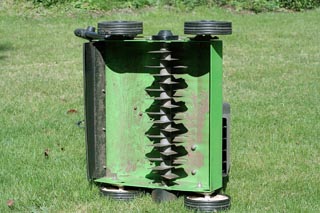 There are copious amounts of lawn products on the market so go in armed the information you need to make the correct purchase, if you haven’t got a weed problem, the proprietary weed and feed is totally unnecessary, whereas a simple moss killer and feed will suffice. Feeding will be important after the winter as a lot of nutrients will simply have been leached away and the remaining grass will need some help to thicken up again.
There are copious amounts of lawn products on the market so go in armed the information you need to make the correct purchase, if you haven’t got a weed problem, the proprietary weed and feed is totally unnecessary, whereas a simple moss killer and feed will suffice. Feeding will be important after the winter as a lot of nutrients will simply have been leached away and the remaining grass will need some help to thicken up again.
Rake out all the moss once it has turned black – there are wonderful machines you can hire if the thought of doing it by hand is too much. Your lawn will look quite dire if there are a lot of weeds/moss but do persevere as it will improve. Any large bare patches can then be oversown with grass seed where necessary. Handful for the lawn, handful for the birds….
 Other jobs to keep you out of mischief include tying in climbing and rambling roses. With climbers, you are looking to create a frame work; tie in the stems you want to keep and prune back to a couple of buds. Remember you want as many horizontal stems as possible as these will produce more flowers.
Other jobs to keep you out of mischief include tying in climbing and rambling roses. With climbers, you are looking to create a frame work; tie in the stems you want to keep and prune back to a couple of buds. Remember you want as many horizontal stems as possible as these will produce more flowers.
Ramblers are a different kettle of fish, as they produce new growth from the base. These will need tying in. Prune out any weak ones and thin the existing old stems. Now is the time to start feeding too; the slow release fertilisers are very easy and they save having to feed so often.
If your primroses have finished flowering, you can divide them now. Keep them in a cool position and water if it is dry (I’m hoping!).
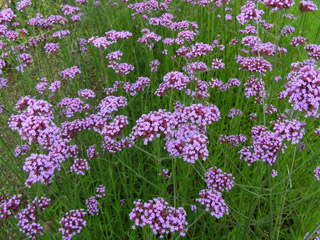
For those of you with big spaces to fill, hardy annuals could be a possibility. A lot can be direct sown in the soil and left to get on with it; love in a mist and night-scented stocks are good reliable examples. There are now some great flower mixes available in shaker packs which give a mass of colour for months.
If the more tender annuals float your boat, start them off either on a windowsill or in a greenhouse. Once they have germinated, prick them out into small pots, (if you need some, help yourself from our recycling bins in the car park; we have loads) and grow them on. If you don’t have a greenhouse, a makeshift cold frame will give adequate shelter and fleece can be a life saver, literally!
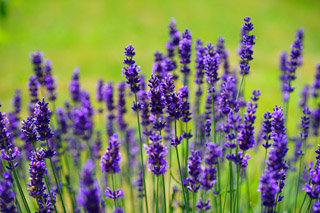 A little advice from someone who has learnt the hard way; if you start your bedding off a little later, they are easier to grow as it’s warmer, and will still be giving you a mass of colour until the first frosts. I’ve seen French lavender in full flower being offered for sale in March, and trust us, that’s not going to be looking amazing when you’re barbecuing in the summer.
A little advice from someone who has learnt the hard way; if you start your bedding off a little later, they are easier to grow as it’s warmer, and will still be giving you a mass of colour until the first frosts. I’ve seen French lavender in full flower being offered for sale in March, and trust us, that’s not going to be looking amazing when you’re barbecuing in the summer.
As for the vegetable garden, it’s full steam ahead. There are vast amounts of seed to be sown, but do take into consideration how many mouths you are feeding. Do you really need to sow 500 cabbage seeds, if it’s guaranteed they’ll all germinate!
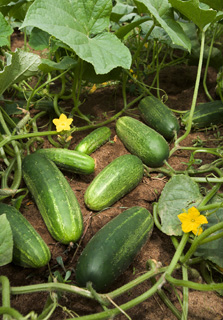 If you are looking for something different to grow, have a look on the Real Seed Company’s website. They have lots of old varieties that you won’t find elsewhere and as they work as a small-scale charity rather than a full-on retail outlet, we don’t mind that competition.
If you are looking for something different to grow, have a look on the Real Seed Company’s website. They have lots of old varieties that you won’t find elsewhere and as they work as a small-scale charity rather than a full-on retail outlet, we don’t mind that competition.
Keep courgettes, tomatoes, cucumbers, sweet corn and runner beans in the warmth for this month, otherwise the cold will check them and they take an age to recover. Carrots, parsnips, spinach, turnips, peas etc can all be sown outside but if you don’t have the time or inclination, packs of small plants are readily available.
Plant yours in small batches and repeat a few weeks later so you have a continuous supply of wonderful home-grown veg. Once growing, don’t forget to feed. We like to use maxi crop seaweed liquid when the plants are small, then move onto pelleted poultry manure.
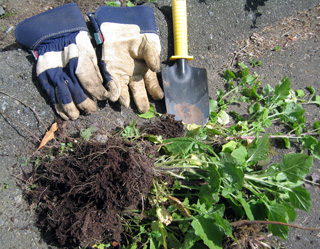 The last job I need to mention is weeding. Ugh. Try, (I know it’s difficult especially when there are so many other fun things to do) and keep on top of them. Not only do they look unsightly but they can also harbour pests and diseases. They also take a vast amount of moisture from your soil as well as using up vital nutrients.
The last job I need to mention is weeding. Ugh. Try, (I know it’s difficult especially when there are so many other fun things to do) and keep on top of them. Not only do they look unsightly but they can also harbour pests and diseases. They also take a vast amount of moisture from your soil as well as using up vital nutrients.
Try and do little and often and keep on top of them; a good mulch of garden compost helps as do carpets and newspaper. Invest in a decent long handled hoe which can be kept sharpened and make the task easier. Just remember, it won’t be long until you can sit out and enjoy the fruits of your labour, hopefully with a large glass of wine.
Sarah Daniel and Helen Robins

